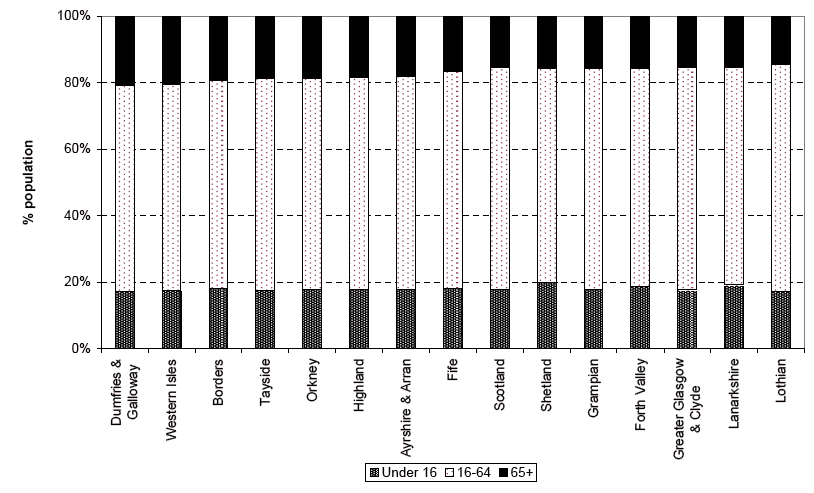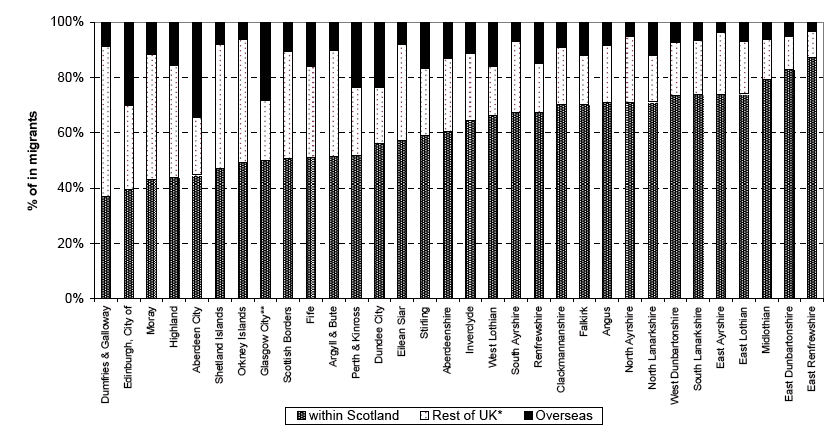
4.1 Population Change 2006-2007
4.1.1 Population estimates for each Council and NHS Board area, together with details of the components of population change (births, deaths, net migration and other changes) for the period mid-2006 to mid-2007, are shown in Table 2, Table 3 and Table 4.
4.1.2 Amongst the Council areas, Clackmannanshire had the largest percentage population increase at +2.0 per cent followed by East Lothian (+1.7 per cent), Perth & Kinross (+1.4 per cent) and Aberdeen City, Aberdeenshire and West Lothian (all +1.2 per cent). Seven councils experienced a decrease in population although the decreases were mainly very small. These were East Dunbartonshire and Inverclyde (both -0.6 per cent), Eilean Siar and West Dunbartonshire (both -0.2 per cent) and Argyll & Bute, Dundee City and East Renfrewshire (where the population fell by less than 0.1 per cent).
4.1.3 For the NHS Board areas, Lothian and Borders (both +1.1 per cent), Grampian (+1 per cent) and Forth Valley (+0.8 per cent) had the largest percentage population increases. The only NHS Board area to have experienced a decline in population was Western Isles although this amounted to only 50 fewer people (-0.2 per cent).
4.2 Components of migration 2006-2007
4.2.1 For most areas, the main cause of population change in the year to mid-2007 was migration. Table 5 shows, for this period, migration flows to and from each Council and NHS Board area for people moving within Scotland (i.e. between one Council area and another or between one NHS Board area and another), people moving between Scotland and the rest of the UK and people moving between Scotland and overseas. In Table 5 and in Figure 5a and Figure 5b movements to and from the armed forces are included in the rest of UK figures.
In-migration
4.2.2 As Figure 5a shows, different Councils attract migrants from different areas. In some Council areas (such as East Renfrewshire, East Dunbartonshire, Midlothian, East Lothian and East Ayrshire) most of the migrants came from other Council areas within Scotland. For example, of the 3,271 people arriving in East Renfrewshire, 2,850 (87 per cent) were from elsewhere in Scotland, 311 (10 per cent) from the rest of the UK and 110 (3 per cent) were from overseas.
4.2.3 In other areas (such as Dumfries & Galloway, Moray, Highland and the Shetland Islands) more than half of the migrants entering the area came from outside Scotland with most of these coming from the rest of the UK. In some cases this will be partly due to movements to and from the armed forces.
4.2.4 In the city authorities, particularly City of Edinburgh, Glasgow City and Aberdeen City, the pattern was again for high proportions of migrants to come from outside Scotland. In Aberdeen City and Glasgow City most of these were from overseas whilst in City of Edinburgh around half were from overseas and half from the rest of the UK.
Out-migration
4.2.5 As Figure 5b shows, there are also differences in the destinations of people migrating out of Council areas. Often the area to which most out-migrants moved was the same area from which most in-migrants had arrived. For example most of the migrants leaving Midlothian, East Dunbartonshire and East Renfrewshire moved elsewhere in Scotland and, as described above, most of the migrants arriving in these Council areas came from elsewhere in Scotland.
Net migration
4.2.8 As a result of these different patterns in both in- and out- migration, some councils experienced net gains from one region but net losses to another whilst others experienced gains from all areas. Only one council – Inverclyde – lost migrants to all areas although the net losses, particularly to overseas, were relatively small.
4.2.9 In some Council areas (such as Aberdeenshire, Fife, Perth & Kinross and West Lothian) more people arrived from each of the regions (within Scotland, Rest of UK and overseas) than left. Even amongst these councils there were different patterns with Aberdeenshire and West Lothian mostly gaining from within Scotland, Fife from the rest of the UK and Perth & Kinross from overseas.
4.2.10 Other Council areas (such as East, North and South Ayrshire) had net gains from other areas within Scotland and from the rest of the UK but lost more than they gained from overseas.
4.2.11 Most of the city authorities lost migrants to other areas of Scotland but gained from the rest of the UK and, in particular, overseas. For example, there was a net gain of over 3,600 migrants in the City of Edinburgh. However, over 2,100 more people left Edinburgh to move elsewhere in Scotland than arrived from the rest of Scotland. There was a gain of almost 900 people from the rest of the UK and of almost 4,900 people from overseas.
Figure 5a Type of in-migration by Council areas, 2006–2007

* Includes moves from the armed forces
** Includes asylum seekers
Figure 5b Type of out-migration by Council areas, 2006–2007
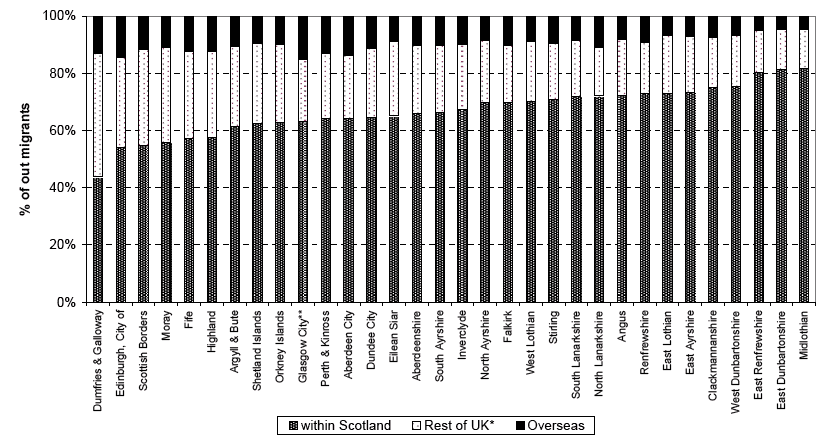
* Includes moves to the armed forces
** Includes returning asylum seekers
4.3 Population Change 1997-2007
4.3.1 Details of population changes between 1997 and 2007 for administrative areas are shown in Table 7. These changes are illustrated for Council areas in the map at Figure 6a and the chart at Figure 6b which both show the percentage change in the population of Council areas between 1997 and 2007.
Figure 6a Percentage change in population, Council areas, 1997-2007 (Map)
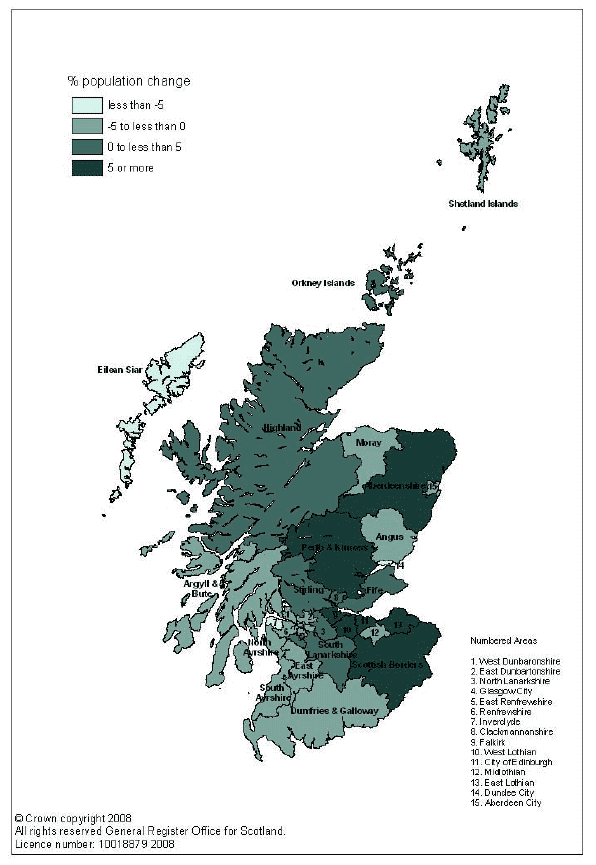
Figure 6b Percentage change in population, Council areas, 1997-2007 (Chart)
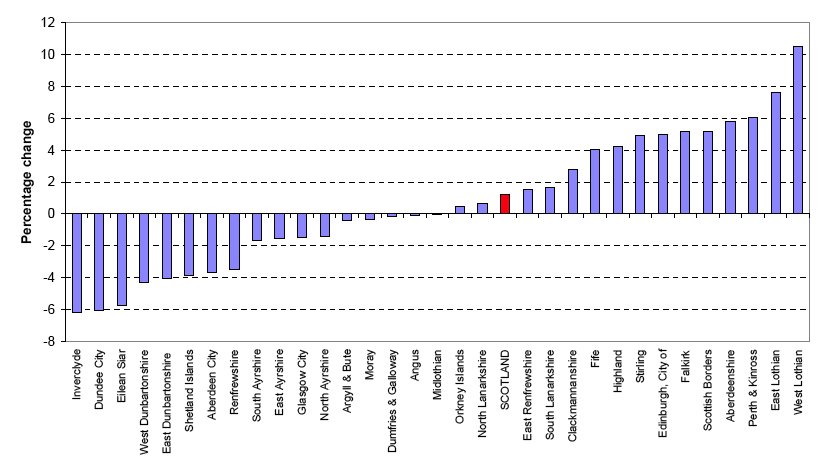
4.3.2 Between 1997 and 2007, West Lothian (+10.5 per cent), East Lothian (+7.6 per cent), Perth & Kinross (+6.1 per cent) and Aberdeenshire (+5.8 per cent) showed the greatest percentage increases for Council areas. The largest absolute increase in numbers was in the City of Edinburgh (+22,350). Inverclyde (-6.2 per cent), Dundee City (-6.1 per cent), Eilean Siar (-5.8 per cent) and West Dunbartonshire (-4.3 per cent) showed the greatest percentage decreases during this period. The largest absolute decrease in numbers was in Dundee City (-9,200).
4.3.3 The map at Figure 7a and the chart at Figure 7b show the percentage change in population between 1997 and 2007 for each NHS Board area. The largest percentage increases in population were in Lothian (+5.9 per cent), Borders (+5.2 per cent) and Forth Valley (+4.5 per cent). The greatest percentage decreases occurred in the Western Isles (-5.8 per cent) and Shetland (-3.9 per cent).
Figure 7a Percentage change in population, NHS Board areas, 1997-2007 (Map)
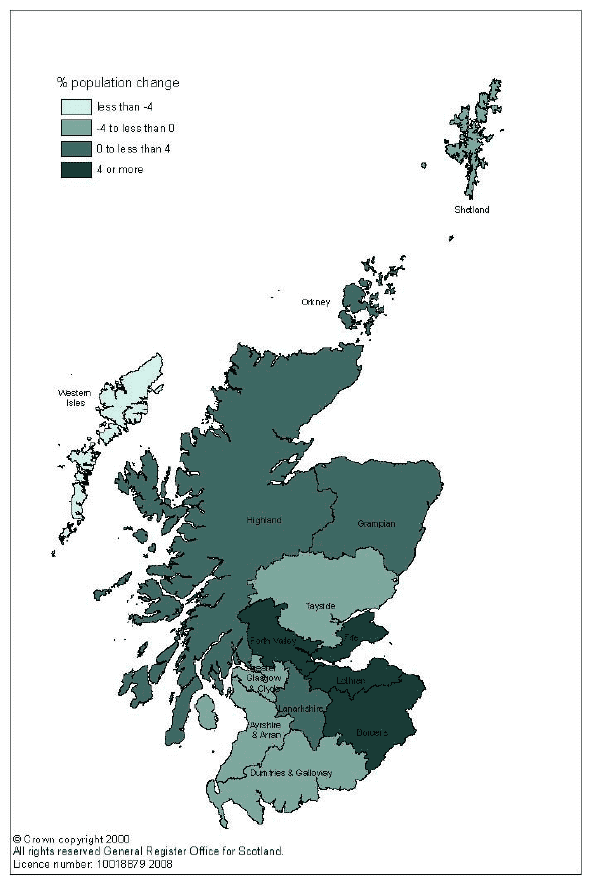
Figure 7b Percentage change in population, NHS Board areas, 1997-2007 (Chart)
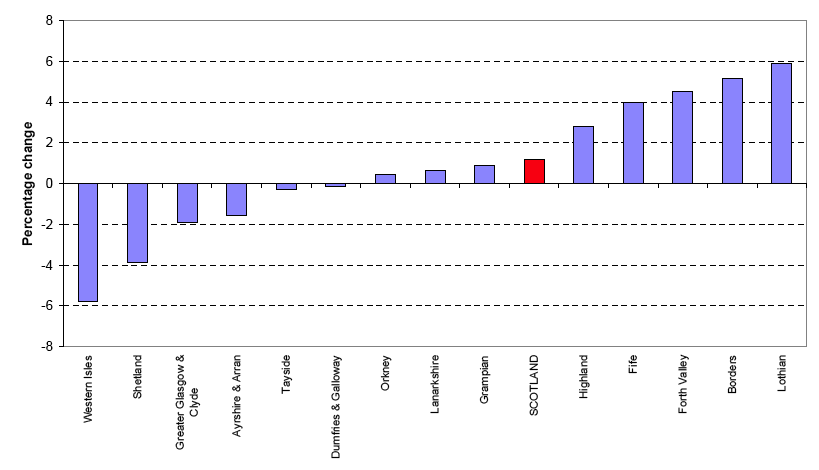
4.4 Sex and Age Structure of Administrative Areas in Scotland
4.4.1 There were more females than males in Scotland in mid-2007 and this is the case for all Council areas other than Moray and Shetland Islands and for all NHS Board areas other than Shetland Islands. Table 8 shows the "sex ratio" for each Council and NHS Board area in Scotland. The sex ratio is the male population divided by the female population (e.g. a sex ratio of 0.95 means that for every 100 females there are 95 males). The sex ratio ranged from 0.90 in Dundee City, Midlothian, North Ayrshire and West Dunbartonshire to 1.01 in Shetland Islands. For the NHS Board areas, the sex ratio ranged from 0.91 in Ayrshire & Arran to 1.01 in Shetland.
4.4.2 Though the pattern of age distribution is complex, some general themes can be seen from Table 8. The major cities had the highest proportions of males and females of working age1. For example, in Edinburgh City 71 per cent of males and 64 per cent of females were of working age and in Glasgow City there were similar results (71 per cent of males and 63 per cent of females). The highest proportions of people of pensionable age2 tended to be in rural areas such as Dumfries & Galloway (19 per cent of males and 30 per cent of females) and Eilean Siar (18 per cent of males and 30 per cent of females).
4.4.3 These patterns can also be seen in Figure 8 and Figure 9 which show the proportion of the population under 16, aged 16-64, and 65 and over for Council and NHS Board areas respectively (sorted by proportion of population aged 65 and over).
Figure 8 Age structure of Council areas, 30 June 2007 (% under 16, 16-64 and 65+)
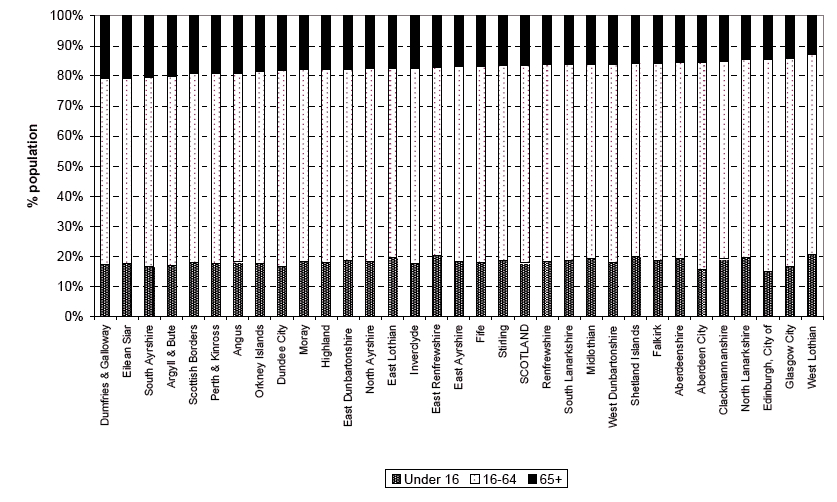
Figure 9 Age structure of NHS Board areas, 30 June 2007 (% under 16, 16-64 and 65+)
